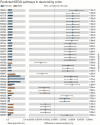Metabolic dysfunction-associated steatotic liver disease exhibits sex-specific microbial heterogeneity within intestinal compartments
- PMID: 39391907
- PMCID: PMC11791572
- DOI: 10.3350/cmh.2024.0359
Metabolic dysfunction-associated steatotic liver disease exhibits sex-specific microbial heterogeneity within intestinal compartments
Abstract
Background/aims: Evidence suggests that the gastrointestinal microbiome plays a significant role in the biology of metabolic dysfunction-associated steatotic liver disease (MASLD). However, it remains unclear whether disparities in the gut microbiome across intestinal tissular compartments between the sexes lead to MASLD pathogenesis.
Methods: Sex-specific analyses of microbiome composition in two anatomically distinct regions of the gut, the small intestine and colon, were performed using an experimental model of MASLD. The study involved male and female spontaneously hypertensive rats and the Wistar-Kyoto control rat strain, which were fed either a standard chow diet or a high-fat diet for 12 weeks to induce MASLD (12 rats per group). High-throughput 16S sequencing was used for microbiome analysis.
Results: There were significant differences in the overall microbiome composition of male and female rats with MASLD, including variations in topographical gut regions. The beta diversity of the jejunal and colon microbiomes was higher in female rats than in male rats (PERMANOVA p-value=0.001). Sex-specific analysis and discriminant features using LEfSe showed considerable variation in bacterial abundance, along with distinct functional properties, in the jejunum and colon of animals with MASLD. Significantly elevated levels of lipopolysaccharide and protein expression of Toll-like receptor 4 were observed in the livers of male rats with MASLD compared with their female counterparts.
Conclusion: This study uncovered sexual dimorphism in the gut microbiome of MASLD and identified microbial heterogeneity within intestinal compartments. Insights into sex-specific variations in gut microbiome composition could facilitate customised treatment strategies.
Keywords: Gut microbiome; MASLD; Metabolic syndrome; NAFLD; Sexual dimorphism.
Conflict of interest statement
The authors have no conflicts to disclose.
Figures








Similar articles
-
Microbiota Co-Metabolism Alterations Precede Changes in the Host Metabolism in the Early Stages of Diet-Induced MASLD in Wistar Rats.Int J Mol Sci. 2025 Feb 2;26(3):1288. doi: 10.3390/ijms26031288. Int J Mol Sci. 2025. PMID: 39941056 Free PMC article.
-
A gut microbiome signature for HIV and metabolic dysfunction-associated steatotic liver disease.Front Immunol. 2023 Dec 14;14:1297378. doi: 10.3389/fimmu.2023.1297378. eCollection 2023. Front Immunol. 2023. PMID: 38162648 Free PMC article.
-
Lactobacillus helveticus HY7804 Modulates the Gut-Liver Axis to Improve Metabolic Dysfunction-Associated Steatotic Liver Disease in a Mouse Model.Int J Mol Sci. 2025 Apr 10;26(8):3557. doi: 10.3390/ijms26083557. Int J Mol Sci. 2025. PMID: 40332012 Free PMC article.
-
Microbiome-centered therapies for the management of metabolic dysfunction-associated steatotic liver disease.Clin Mol Hepatol. 2025 Feb;31(Suppl):S94-S111. doi: 10.3350/cmh.2024.0811. Epub 2024 Nov 28. Clin Mol Hepatol. 2025. PMID: 39604327 Free PMC article. Review.
-
Metabolic dysfunction-associated steatotic liver disease and the gut microbiome: pathogenic insights and therapeutic innovations.J Clin Invest. 2025 Apr 1;135(7):e186423. doi: 10.1172/JCI186423. J Clin Invest. 2025. PMID: 40166938 Free PMC article. Review.
Cited by
-
Triglyceride-glucose-waist circumference index: A powerful tool for metabolic dysfunction-associated steatotic liver disease.World J Hepatol. 2025 Jul 27;17(7):107668. doi: 10.4254/wjh.v17.i7.107668. World J Hepatol. 2025. PMID: 40747214 Free PMC article. Review.
-
MASLD: Prevalence, Mechanisms, and Sex-Based Therapies in Postmenopausal Women.Biomedicines. 2025 Apr 2;13(4):855. doi: 10.3390/biomedicines13040855. Biomedicines. 2025. PMID: 40299427 Free PMC article. Review.
-
Gut-Liver Axis: The Role of Intestinal Microbiota and Their Metabolites in the Progression of Metabolic Dysfunction-Associated Steatotic Liver Disease.Gut Liver. 2025 Jul 15;19(4):479-507. doi: 10.5009/gnl240539. Epub 2025 May 8. Gut Liver. 2025. PMID: 40336226 Free PMC article. Review.
-
Characteristics of serum bile acid profiles among individuals with metabolic dysfunction-associated steatotic liver disease.BMC Gastroenterol. 2025 May 5;25(1):334. doi: 10.1186/s12876-025-03903-1. BMC Gastroenterol. 2025. PMID: 40325371 Free PMC article.
References
-
- Rinella ME, Lazarus JV, Ratziu V, Francque SM, Sanyal AJ, Kanwal F, et al. A multisociety Delphi consensus statement on new fatty liver disease nomenclature. J Hepatol. 2023;79:1542–1556. - PubMed
-
- Brunt EM, Wong VW, Nobili V, Day CP, Sookoian S, Maher JJ, et al. Nonalcoholic fatty liver disease. Nat Rev Dis Primers. 2015;1:15080. - PubMed
-
- Mouzaki M, Comelli EM, Arendt BM, Bonengel J, Fung SK, Fischer SE, et al. Intestinal microbiota in patients with nonalcoholic fatty liver disease. Hepatology. 2013;58:120–127. - PubMed
MeSH terms
Substances
Grants and funding
- Agencia Nacional de Promoción Científica y Tecnológica
- PICT 2018-889/Fondo para la Investigación Científica y Tecnológica
- PICT 2019-0528/Fondo para la Investigación Científica y Tecnológica
- PICT 2018-00620/Fondo para la Investigación Científica y Tecnológica
- PICT 2020-SerieA-0799/Fondo para la Investigación Científica y Tecnológica
LinkOut - more resources
Full Text Sources

